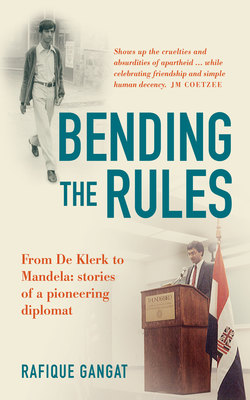Читать книгу Bending the Rules - Rafique Gangat - Страница 9
На сайте Литреса книга снята с продажи.
BLACK HEN, WHITE EGGS
ОглавлениеLove across the colour line
The time I spent with Ann was mostly in Hillbrow, a densely populated and cosmopolitan part of Johannesburg, made so by the large influx of Europeans attracted to the City of Gold. It was the grey in the apartheid separation between black and white.
Hillbrow never slept and had a unique vibe, distinct from the rest of the city and South Africa. At the time, Gerry Rafferty’s hit song “Baker Street” blared from the eateries near the Highpoint skyscraper landmark. You could have been forgiven for imagining you were in New York or any inner city in the US or Europe.
My friend Audrey, an attractive black woman who bore a striking resemblance to Diana Ross of The Supremes, was a successful entrepreneur who lived and ran a business there. She operated under the ownership of a white person because the apartheid laws prevented her from owning a business in what was designated a “whites-only” suburb. She designed clothes, had them made up on the Indian side of town and then sold them to a mainly white clientele. They thought she was a shop assistant and had no idea that she owned, designed, and managed the entire operation, which was even called Audrey’s.
She was a gutsy, street-smart woman, and a friend I held in high regard. She lived in a fancy apartment under cover of it being rented by a white person who was really her boyfriend, and she masqueraded as a maid and nanny to two beautiful blonde green-eyed little girls. The reality was that they were her daughters and their father was her Swiss lover, Walter, who travelled between Geneva and Johannesburg. Strangely, the girls bore no resemblance to Audrey at all.
Audrey had often served as a perfect cover for Ann and me. If the police confronted us, she would pretend to be my girlfriend while Walter pretended to be Ann’s boyfriend. That’s the way we survived in the minefield of laws that forbade relationships across the colour line.
Audrey’s daughters attended a whites-only pre-school, and she was always adept at keeping one step ahead of the apartheid laws that she had transgressed. She had violated the Immorality Act by engaging in a sexual relationship with a white person and she was living illegally in a suburb designated for whites only, falling foul of the Group Areas Act.
The white police enforcing these racist laws would often break into the homes of suspected mixed-race couples at odd times, hoping to catch (and photograph) them in bed together. This, and other incriminating evidence such as sheets with traces of semen, would be presented as evidence in court when the couple was prosecuted.
In one of these early-morning raids, the police broke into Audrey’s apartment. They were probably anticipating that they’d find her in bed with Walter, but he had left the evening before.
The flimsy charge they levelled against her was that she was living in the apartment illegally, to which she responded that she was the live-in maid and nanny. Although this was illegal, it was to some extent acceptable because the father of the girls travelled between Geneva and Johannesburg.
It looked as if Audrey had her bases covered until, with all the commotion, her daughters woke up and came into her room rubbing their eyes and crying, “Mummy, Mummy!”
The police were shocked to see two white girls with green eyes and blonde hair calling a black woman Mummy. Their eyes widened as she cuddled her daughters and warmly allayed their fears. In doing so, she had courageously defied the police.
Then, true to her nature, spirit, and courage, Audrey looked the policemen in the eye and asked defiantly: “Have you not seen a black hen lay white eggs?”
Seeing mother-and-daughter love manifest itself before their prying eyes, transcending colour, the police left without another word.
